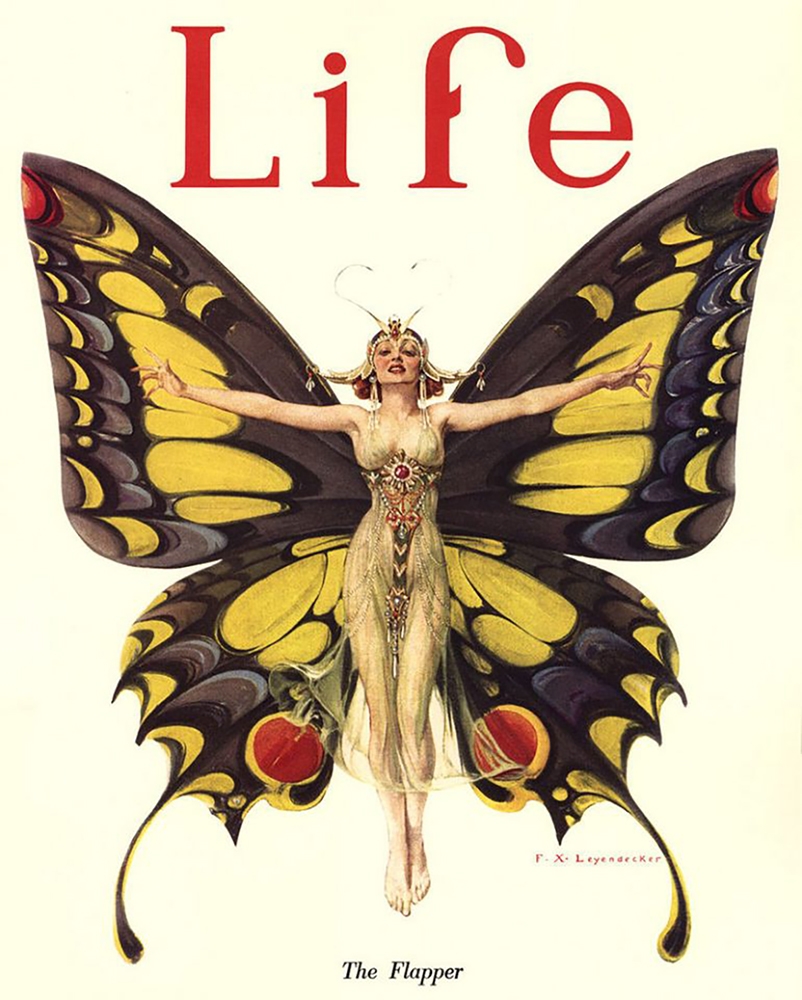Winner of the Fall 2016 StMU History Media Award for
Best Article in the Category of “Culture”
When one thinks of the 1920’s era one immediately thinks about Flappers. A flapper was considered a young woman who was very fashionable. This was a young female who enjoyed life to the fullest, flouting her unconventional standards of behavior and carefree party lifestyle.1 The spirit behind this movement was all about leaving the traditional ways of life behind and transforming into an independent woman.

Before World War I, the concept of femininity was referred to as the Gibson Girl. This term was used to describe these new independent and often well educated women. Gibson girls wore their hair long, pinned up and adorned with beautiful hats. They completed their ensemble by wearing long skirts and blouses that buttoned up to their necks. Despite their feminine appearance, these women were more than capable of doing the same things that men did. Examples of this include activities such as playing sports: skating, golfing, bicycling, tennis. These young ladies did not go out until they were asked properly by a young man who had good intentions and a promise of marrying them. Gibson Girls soon broke away from their traditional ways.2
In 1915, two years before America’s entry into World War I, a famous author by the name of H.L. Mencken introduced the word “Flapper” to the United States. Mencken stated that a flapper was “a woman who consumed music, literature and periodicals voraciously taking her cues for behavior and style from the media in front of her rather than the moral codes of decorum.”3 Another famous author, F. Scott Fitzgerald, famous for his classic novel The Great Gatsby, described the flapper as “lovely, expensive, and about nineteen.” John Held Jr., who was an American cartoonist, emphasized the flapper by drawing young girls wearing unbuckled galoshes that would make a “flapping” noise when walking.4 Despite the many different terms, Flappers were described essentially the same way: they were young girls who enjoyed the party life and had a sense of fashion.
After World War I ended in 1918, many things had changed for the men returning home, particularly the roles and values that women were embracing. The traditional values were gone and in their place came a faster, sleeker, and more daring approach to life. This time period not only ushered in an era of change in values, but it also established a new baseline for what was considered feminine. The Flapper Age was born and it brought with it a new and independent woman. These women smoked, drank, voted, cut their hair into bobs, wore eyeliner, and went to as many parties as they could—enjoying every bit of the social life along the way.5

During the 1920’s, fashion changed drastically due to a very famous designer, Coco Chanel. This woman helped flapper fashion to stand on its own. Typical flapper clothing included a simple sack like dress, which allowed women of all classes to make their own dresses and remain on trend.6 The waist of the dress was dropped to the hipline, and the skirt fell just below the knee. Stockings made of rayon were added and worn over a garter belt. To complete the look, bracelets were added and necklaces ran from the neck to the waist. Cloche hats sat atop their heads and drew the eye into a new hairstyle trend known as the bob.7 The make-up of flappers consisted of a red powder or cream that was used for the lips and cheek, eye-liner, powder for the face, and red lipstick that became very popular.
On January 19, 1919, the Eighteenth Amendment, also known as the Volstead Act, came into effect and gave way to the Prohibition Era in which the sale, production, importation, and transportation of alcohol was banned across the nation.8 This change in the legal system caused the sale and consumption of liquor and alcohol to go underground. The most rebellious thing a flapper could do at this time was to consume alcohol, and these young girls had a reputation for being giddy. The following year, on August 18, 1920, the Nineteenth Amendment was passed and women now had the right to vote.9 In 1924, the first radio launched more than 600 commercial channels around the U.S. The radio at the time was the social media on the flapper life. Many young girls swarmed the theaters to see the image of the flapper on screen. Famous actress Clara Bow, starred in the “Flapper” and made the look iconic.
On December 2, 1927, Henry Ford invented the Model A vehicle and car sales increased.10 Women were now owners of vehicles, and the car became a lifeline to a world full of excitement for the flapper in particular. With no one to stop them, they were free to come and go as they pleased. Liberated women were now able to go out and enjoy dancing during this era that was the Jazz Age. The most popular thing for a flapper to do was to go to a nightclub where she would drink, dance, and show off her moves. The era of the Flapper, however, came to an end with the Wall Street Crash of 1929. Many young women lost their jobs and the incomes that had given them such independence.11
Life in the 1920’s left a huge legacy for women to this day. Flappers and the forward-thinking concept of the modern woman is what initiated the change in society for how women were viewed then as well as how they continue to be viewed in present day. With their bold choice in attire, along with their new views and attitudes regarding femininity, both in fashion as well as social conduct, Flappers left behind the old traditional ways and paved the road for a more liberated female.
- Salem Press Biographical Encyclopedia, January 2016, s.v. “Flappers,” by R.L. Smith. ↵
- Kelly B. Sagert, Flappers: A Guide to an American Subculture (Greenwood Publishing Group, 2010), 1-2. ↵
- Brian DiPaolo, Flappers: Issues & Controversies in American History (Infobase Publishing, 2007), 4-5. ↵
- DiPaolo, Flappers: Issues & Controversies in American History, 4-5. ↵
- Soo Hyun Park, Flapper Fashion In the Context of Cultural Changes of America in the 1920’s (CUNY Academic Works, 2014), 1-2. ↵
- Salem Press Biographical Encyclopedia, January, 2016, s.v. “Flappers,” by R.L. Smith. ↵
- Sagert, Flappers: A Guide to an American Subculture, 3. ↵
- Sagert, Flappers: A Guide to an American Subculture, 5. ↵
- DiPaolo, Flappers: Issues & Controversies in American History, 2. ↵
- F.L. Allen, Only Yesterday: An Informal History of the Nineteen Twenties (National Humanities Center, 1931), 5. ↵
- Alan Brinkley, American History: Connecting with the Past Volume 2, 15 edition (New York: McGraw-Hill Education, 2014), 643. ↵




213 comments
Hector Garcia
It seems like the flappers did indeed leave a mark in history. Their audacity and charisma sure sounded like they could have made young and fine women. It was interesting to read about these incredible and revolutionary women. I really enjoyed how to read how the flappers were depicted in the early twentieth century. It was sad to see that the era of the flapper ended when it was barely in its infancy.
Natalia Flores
This article reminded me of Chicago, the musical. It also reminded me of The Great Gatsby which is a thumbs up from me to the author since they added that into their article. The time of the Flapper was one of parting, breaking the rules, and being free. Just reading the article made me giddy with excitement since I can only imagine what it must have felt like to go from being a gentle, nicely dressed woman that couldn’t go to work or go out in general without permission to a party goer, drinking alcohol, and owning/driving their own car.
Iris Henderson
With the new roaring twenties around the corner, I can’t help but feel that women are also on the cusp of a large and groundbreaking movement. I really enjoyed reading how women found independence first through fashion and expressing themselves through it. This lead to more confidence and women fighting for greater independence. I can see the relation through the two and feel that true equality is on its way!
Saira Castellanos
I wish sometimes i was a white rich woman in the twenties, enjoying life to the max, just going to parties and dancing all night long. Its crazy how woman changed in the twenties, and how they dressed. I love the whole rebellious thing that these flappers did, and this really shows the movement into feminism and changes into how woman are treated. Its amazing how just clothing can represent a rebellion. Great article
Hanadi Sonouper
This was such a great article to read, especially because it promotes how much the culture around woman has changed for the better. Woman have always played an essential role in our history with being the care givers at home, and portraying an almost conservative type of clothing. However, the twenties was a time to show that woman can be empowered and strong minded yet promote an aspect of fashion and sensuality. I commend the author for writing this article, it was interesting to read the highlights of the iconic Flapper girl.
Timothy ODekirk
I am a huge fan of the Roaring Twenties. The fact that the look of women has changed drastically during this outrageous decade is quite astonishing. Before the roaring twenties, it was seen as inappropriate for women to show any part of their skin. Now, during the roaring the twenties, women wore more revealing clothing, and were outgoing.
Tyler Thompson
It’s crazy to think that the word flapper would be instituted into something that would change the idea of women and traditional values. The twenties did a lot in terms of giving more power to the female. Flappers became more of a lifestyle and a form of expression through dress attire. It was very interesting to read that a famous clothing line like Coco Channel, was a big part of what happened almost one hundred years ago. It’s crazy to see how much has changed today, and how social movements like these could have been the reason for it.
Anna Guaderrama
The idea of flappers has always held a sort of pizazz for me, but not necessarily because of the aesthetic that was overrated when the movie The Great Gatsby came out but because of the symbol they held at the time. I love how they went out of the norm of what a woman was supposed to be like and chose to live their best lives at the time. It’s the idea of a liberated woman that I feel like holds so much power because it takes away the constraints that at the time were customary and proposes a new image.
Natalie Childs
This was a great article, and I absolutely loved the featured image. I knew a fair amount of Flapper girls before reading this article, but I never knew what preceded them (Gibson girls) and how World War I sort of pushed this culture of women along. I think this article did a great job of showing just how much change can come from women, even when it involves dancing and fashion.
Jasmine Jaramillo
The 1920s was a time of change, especially for women. I think it’s interesting that women started to take control of the way they dressed to show they were rebellious and wanted change. Flappers were the gateway for today’s modern women. We owe it to these forward-thinking women that decided that the only way to make change happen was to demand it. I really enjoyed how the article gave multiple examples of how flappers made a difference in the 1920s.